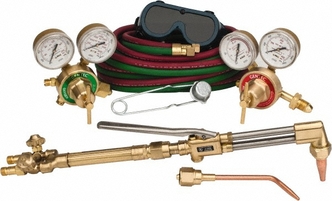Need Some Help?
Welding sheet metal
- Weld using a neutral flame (just off feather)
- 4 to 4.5 PSI equal oxygen and acetylene.
- Lock trigger in off position.
- A light preheat to knock the chill out and stress relieve the metal
- Weld up to 1/2″ thick metal. Thicker metals require longer preheating.
- To prevent distortion in the metal leave a 1/16″ to 1/8″ inch gap between the pieces being welded.
- No Flux is required.
- Rusty or dirty is not a problem.
- On large pieces tack weld about every 1″ inch to 1 1/2″ inches.
- On material 1/8″ or thicker requires grinding a V bevel on the edges.
- Weld using the tip of the flame. Lower your flame and rod onto the weld together, walk the flame up and down the rod washing the molten filler back into the puddle. Thicker material may require a slight oscillating motion to keep both sides red hot.
- Select your Rod according to purpose.
- Generally copper coated TIG rods.
- If your doing auto body sheet metal use RG-45 / RG-60 TIG rods, they hammer and dolly very nicely.
- You can use a coat hanger, but not recommended.
- You can also shear small strips of excess material and use as a welding rod.
- Eletrodes may be used by knocking off the flux.
Setting up the torches
- With your tanks open and output regulators closed, open the guns oxygen and acetylene valves turns.
- Lightly crack the acetylene regulator enough to light the torch.
- Slowly open the acetylene regulator valve until you get about a two foot flame and there is no black smoke. Your regulator output reading should be 4 to 4.5 PSI.
- Lightly crack the oxygen regulator and slowly open until you get a neutral flame (Best viewed with goggles on). As you turn the oxygen up you will see an outer feather start to drop down. Keep slowly opening until the feather just disappears. The flame should be about 1/2″ to 9/16″ of an inch. That is a neutral just off feather flame that is extremely critical for all cutting and welding applications.
- If you have 50′ hoses you need to increase your pressure 1 to 2 PSI
- Use quality regulators that do not fluctuate in pressures, as this will only corrupt your cutting and welds.
- Using the Cobra low pressure regulators is much easier. With the gun valves and regulators closed , open your acetylene1/4 turn and open your oxygen.
- Set each one to 5 PSI. They will drop down to 4 PSI once you start using the Torch.
Welding Stainless steel
If it is magnetic, a 308 or 309 TIG rod may work well. If non magnetic, a 308 or 316 TIG rod may work well. You can also shear excess metal off and use as a welding rod. |
Welding Cast iron
|
Welding Aluminum
|
Welding Chrome-moly
|
Cutting sheet metal
1/8″ use 6 PSI 22 GA up to 18 GA use 4 to 4.5 PSI
|
Cutting thick steel
1/2″ use 15 PSI 1/4″ use 8 to 10 PSI
|



